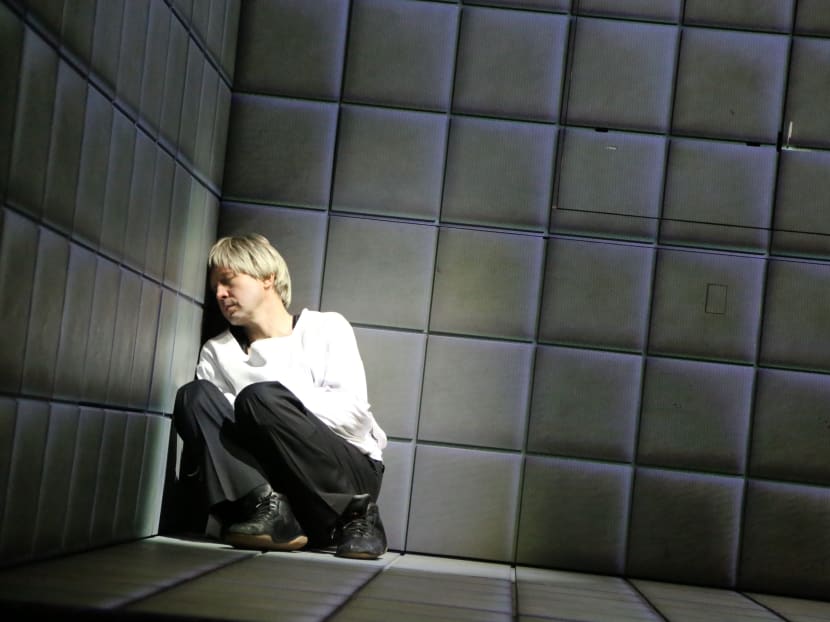Theatre review: Hamlet | Collage
SINGAPORE — Whatever one expects from a performance titled Hamlet | Collage and billed as a production featuring “startling video technology”, it could hardly be this: a surprisingly faithful rendition of Shakespeare’s original play.


SINGAPORE — Whatever one expects from a performance titled Hamlet | Collage and billed as a production featuring “startling video technology”, it could hardly be this: a surprisingly faithful rendition of Shakespeare’s original play.
Dramaturg Roman Dolzhansky’s adaptation adds a few lines that hint at the production’s setting (Soviet Russia), but on the whole and judging from the Shakespearean verse flashed up on the surtitles, Hamlet | Collage, which was staged last Friday and Saturday (Aug 12 and 13) as part of the Singapore International Festival of Arts, remains remarkably true to its original source material.
Where it departs from most productions of this play is in its inventive performance and staging.
For instance, the show is essentially a one-man performance of Shakespeare’s famous tragedy, staged in a rotating white box. With a total of 20 characters, Hamlet would seem a daunting task for any person hoping to distill it into a one-man show.
However, Dolzhansky and director Robert Lepage accomplishes this in style, and the result is a tour de force by Russian artist Evgeny Mironov, who singlehandedly takes on the roles of 11 characters from Shakespeare’s play over two and a half hours (with the assistance of Vladimir Malyugin providing the occasional extra arm and body double).
Occasionally aided by the use of technology (one memorable scene saw him address the characters of Rosencrantz and Guildernstern by talking to two projections of himself on either side of him), Mironov more often switches between characters the old-fashioned way: with a quick change of costume, a wig or two, the lowering or raising of the timbre of his voice, and inhabiting each character’s tics and quirks.
It is the staging, though, that initially takes one’s breath away. Mironov performs the entire play on a large open-sided cube designed by Carl Fillion that is suspended and spun in mid-air above the stage. The cube’s walls start out gridded and padded to resemble an asylum cell.
As Mironov frees himself from the constraints of a straightjacket though, a door suddenly slams open and, with the aid of projections, the padded surface of his cell ripple and change into the stone walls and floors of a grand room flanked by large windows.
That initial moment of transportation (from asylum to “Elsinore”) was followed by more. We discover openings in the floor and walls of the cube through which television sets, CCTV monitors and other props emerged; we see how a cube rocked from side to side could resemble the motion of a moving boat; and Ophelia’s death by drowning is brought dreamily to life with the combination of a hole in the floor of the cube and projections of rippling water.
As inventive and interesting as this production is, though, Lepage’s production does have some misses. Firstly, watching a single cube spinning around an axis and projections after projections dissolve and fade into one another for two-and-half hours has a highly soporific effect. The production’s dream-like quality may gel with a conception of Hamlet as a play that takes place within the mind of a single (mad) man, but it does have other, less desirable, side-effects (I saw many in the audience fidgeting in an effort to stay awake).
The production also relegates Hamlet to being the least interesting character in his own play. In Mironov’s performance, all the other characters inhabiting Elsinore appear to spring from Hamlet himself and they are colourful, lively and distinct. There is Polonius, the fussy, bumbling and pill-popping Soviet KGB bureaucrat; Gertrude, the paparazzi-loving sunglass-toting fashionista; Claudius, the Lenin-like character with a limp and stiff leg.
Compared to them, the character of Hamlet comes across as bland — a mere template upon which all the other, more interesting fictions of his mind’s creation, might be writ upon. Lepage and Mironov may have intended to comment on the way that Shakespeare’s Hamlet ends up being a character lost and astray in his own revenge play, but there have been other productions that have been able to highlight that aspect of Hamlet while embracing his character’s distinctive fire and wit.
Mironov’s Hamlet, though, comes across as tired and colourless. All of the actor’s wit and inventiveness is channelled into the other characters instead, and for the first half of the play, I actually found myself forgetting all about Hamlet as Mironov threw himself into exploring the other characters inhabiting Elsinore.
In the end, Hamlet | Collage paints a pretty picture, but one does end up questioning how much of a Hamlet a production that so neglects its central character can really amount to.





